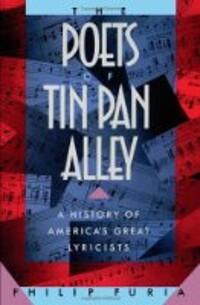Status
Call number
DDC/MDS
| 782.42164 F984p |
Publication
Description
From the turn of the century to the 1960s, the songwriters of Tin Pan Alley dominated American music. Irving Berlin, Cole Porter, George and Ira Gershwin, Rodgers and Hart--even today these giants remain household names, their musicals regularly revived, their methods and styles analyzed and imitated, and their songs the bedrock of jazz and cabaret. In The Poets of Tin Pan Alley Philip Furia offers a unique new perspective on these great songwriters, showing how their poetic lyrics were as important as their brilliant music in shaping a golden age of American popular song. Furia writes with great perception and understanding as he explores the deft rhymes, inventive imagery, and witty solutions these songwriters used to breathe new life into rigidly established genres. He devotes full chapters to all the greats, including Irving Berlin, Lorenz Hart, Ira Gershwin, Cole Porter, Oscar Hammerstain II, Howard Dietz, E.Y. Harburg, Dorothy Fields, Leo Robin, and Johnny Mercer. Furia also offers a comprehensive survey of other lyricists who wrote for the sheet-music industry, Broadway, Hollywood, and Harlem nightclub revues. This was the era that produced The New Yorker, Don Marquis, Dorothy Parker, and E.B. White--and Furia places the lyrics firmly in this fascinating historical context. In these pages, the lyrics emerge as an important element of American modernism, as the lyricists, like the great modernist poets, took the American vernacular and made it sing.… (more)
User reviews
In the case of this book, it's an unfulfilled promise. The subtitle is "A History of America's Great Lyricists." But when you get to the preface, you'll learn that the book is mostly about a particular era (between the two World Wars). Then, when you get to the actual book,
For a class on twentieth century American popular poetry, this book probably has a place -- it points out things I would never, ever have thought of, such as the use these lyricists made of internal rhyme. But it isn't history and it isn't biography. And that means it isn't what it claims to be.
If you read it with that warning in mind, you may like it. I came away only mildly educated, and thoroughly irritated. Indeed, I felt like I had been lied to.
Song characteristics
-- influence of Vers de société or light verse: urbanity and flippant tone, with an ironic and casual manner
-- introduction of colloquialisms (rag) over arch poetic scansion (ballad) of European tradition
-- list songs were favourites, the placename list a specific variety of same
-- clever rhyming a hallmark: Porter, Hart, Gershwin
-- emphasis upon "singable" aspects: sonority of vowels, alliteration of consonants as important as rhyme
-- integrated songs could do without rhyming by linking to plot, character, or regional style of show; uncommon until Oklahoma! (1943)
Industry inflection points
-- stooge singers placed in audience of variety shows, to boost popularity of specific songs (was Iggy aware of this use of the term?)
-- interpolated songs took popular songs and placed in unrelated variety show, single song could be placed in several shows; "hot show" was one with a strong hit
-- 1940s saw recording sales outsell sheet music for the first time; Tin Pan Alley used Broadway as a marketing delivery system, the point was to sell sheet music
-- battle between ASCAP (publisher of sheet music) and BMI (publisher of recordings) came to a head with ASCAP's radio contract set to expire in January 1941; radio shifted over to BMI before ASCAP could negotiate new contract, and when it was finally ready there was already a shift to "hillbilly" or "roots" recordings from BMI, which ASCAP had avoided
-- Tin Pan Alley format: 32-bar, AABA (with 3 strophes, 3 refrains in 4x8 structure?)
-- Blues standards format: 12-bar, AAB (in 3x4 structure?)
